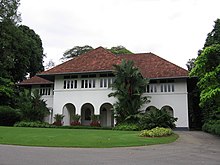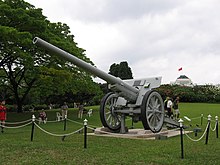Istana (Singapore)
The Istana ( German palace ) is the official residence of the President of the Republic of Singapore . The building is located in extensive open land in the otherwise highly urbanized area of Orchard Road.
In 1867 the British colonial government purchased the property and built a stately home on it. Until 1959, the palace served as the seat of the British governor. The property retained this status until Singapore was granted self-government in 1959 and the British governor was replaced by Yang di-Pertuan Negara ( head of state in German ). Since Singapore gained independence from Malaysia in 1965, the Istana has been the seat of the President of Singapore , where Halimah Yacob has resided since 2017 .
history
British colonial times
The 106 hectare (0.4 km²) estate was once part of an extensive nutmeg plantation on Mount Sophia, a small hill in the area called Rochore . In 1867 the British colonial government purchased the area. Between 1867 and 1869, on behalf of Sir Harry Saint George Ord, the first British Governor of Singapore, a stately building, today's Istana, was built on what was initially known as the Government House . The property also includes the Sri Temasek , one of several residences of high-ranking colonial officers of the Istana, which was originally the residence of the Colonial Secretary.
Ord's desire for a stately residence arose out of his dissatisfaction with the rented building on Grange Hill and Leonie Hill. Another former governor's residence on Bukit Larangan (now Fort Canning Park ), which was made of simple wooden architecture , was demolished to make way for the fort and had never been replaced.
Ord's views met with abundant opposition from his colleagues who viewed the cost of building a palace of palatial proportions as too extravagant. Ord withstood the criticism, however, and finally acquired a 0.43 km² nutmeg plantation in 1867 from a certain CR Prinsep. Construction began that same year after the design was completed in March 1867.
The construction of the entire Government House, its property and the outbuildings was carried out by convict workers - JFA McNair Supervisor for the construction of the Government House, was also responsible for the convicts of the colony. The building, imposing on completion, was completed just in time for a visit by the Duke of Edinburgh . In retrospect, it was admired by its residents, writers and visitors alike .
Second World War
Bombardments during the Japanese invasion in 1942 destroyed the small ceremonial gun that stood on the steps of Government House, leaving nothing but ruins of the building and property. The governor Sir Shenton Thomas , who was in office at the time , finally had to give up the building with his wife Lady Daisy Thomas and had himself evacuated. During the occupation the house was inhabited by Field Marshal Count Terauchi , Commander in Chief of the Japanese Southern Army , and Major General Kawamura, Commander of the Defense Forces of Singapore.
post war period
After Singapore became self-governing in 1959, the building was handed over to the new government and renamed Istana. The first local head of state to take over the residence was Yusof bin Ishak , who bore the title Yang di-Pertuan Negara .
The building was extensively renovated between 1996 and 1998 to gain more space and to add modern amenities to the structure. The building now has six function rooms that can be used for ceremonial events and entertainment purposes. The offices of the President and his staff are also located within the building.
present
Since its first occupation in 1869, 21 governors (1869-1958), two Yang di-Pertuan Negara (1959-1965) and six presidents (since 1965) have served in the Istana, not to mention the commanding officers during the occupation the Japanese between 1942 and 1945.
Today the Istana is the official residence of the President of Singapore. However, since 1959, the palace has not been inhabited by a president or a cabinet minister. The mansions, originally intended to house foreign heads of state, are also rarely used for this purpose. The Istana's buildings and grounds are open to the public on five selected public holidays - Chinese New Year , Diwali , Ramadan , Labor Day, and National Day . Since in some years the festivities of Diwali and Hari Raya Puasa (Ramada) are very close to each other, the Istana is only open on one day during this time, representative of both holidays. At other times the property is mostly used for state purposes and ceremonial occasions, such as swearing-in and appointments, as well as for administrative tasks. The prime minister has his seat in one of the outbuildings of the Istana.
A parade takes place on the first Sunday of the month as part of the changing of the guard , which is now a popular public event.
architecture
The architecture of the Istana is similar to the Neo-Palladian style of many other buildings from the 18th century and was developed by British military engineers in India. It has a tropical facade that is modeled on a Malay house, which is lined with statuesque columns and surrounded by wide verandas, windows and paneled doors, which facilitate the passage of air and thus ventilation. The central three-story tower block, 28 meters high, is the defining element of the building. The relatively well-proportioned two-storey side wings show Ionic , Doric and Corinthian orders including Ionic colonnades on the second floor and Doric colonnades on the first floor. The building stands on a small hill, which allows a view of the stately property and the entire estate, which is reminiscent of the great gardens of England.
The property also includes:
- Sri Temasek, also built in 1869 for the Colonial Minister, was the Prime Minister's official residence
- various outbuildings
- the Istana Villa (built in 1938)
- The Lodge (1974)
- the Japanese gun that was given to Lord Louis Mountbatten after the Japanese surrender in 1945
- March Garden (1970)
- Lilies ponds
- a nine-hole golf course
- a burial site for the Bengkulu who came to Singapore between 1825 and 1828 can be found on the southern slopes of the site near the entrance to Orchard Road.
literature
- National Heritage Board: Singapore's 100 Historic Places . Archipelago Press, 2002, ISBN 981-4068-23-3
- Norman Edwards, Peter Keys: Singapore - A Guide to Buildings, Streets, Places . Times Books International, 1996, ISBN 9971-65-231-5
- President's Office, Istana: The Istana .
Web links
- Istana Singapore - Official Site of the Presidential Office
- The Istana and Sri Temasek on roots.sg, the website of the National Heritage Board of Singapore (English)
Coordinates: 1 ° 18 ′ 25 " N , 103 ° 50 ′ 35" E




